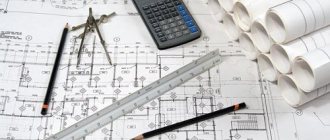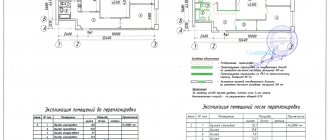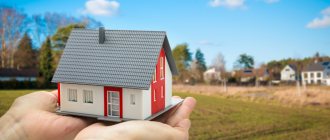Article 50. Requirements for residential premises
A comment :
1. According to the content of the commented article, criteria are established for residential premises that are provided to a person for residence. It must be well-equipped in relation to the conditions of a given locality and meet established sanitary and technical requirements.
Sanitary and technical requirements provide conditions under which a person can live without harm to her health. Landscaping is determined by the presence of communal amenities in the residential premises (water supply, sewerage, heating, gas supply, etc.).
Thus, a room may meet sanitary and technical requirements, but be disorderly, and vice versa. It should be taken into account that the level of improvement in different settlements and localities is different.
Therefore, the legislation connects the solution to the issue of the convenience of the provided residential premises with the specific conditions of the locality in which it was provided.
2. Residential premises provided to a citizen who is on the housing register do not necessarily have to be located in a new house. Vacant residential premises may also be provided if they meet the established requirements.
Providing citizens with residential premises that do not meet the established requirements is permitted only in cases of temporary improvement of housing conditions in the manner prescribed by the Apartment Registration Rules.
In particular, according to paragraph.
54 of the Rules, in some cases, at the request of citizens who are on the housing register (primarily those who have a priority for receiving residential premises), and citizens enjoying the right of priority receipt of residential premises in order to temporarily improve housing conditions, they may be provided with residential premises , which does not meet the requirements for livability, sanitary and technical requirements provided for, with the corresponding retention of the right to be registered and on the priority list or on the non-priority list.
3. According to Part 2 of Art. of the commented article, when providing residential premises, it is not allowed to occupy one room by persons of different sexes, over nine years of age, except for spouses. Apartment registration rules (clause
52) an additional ban has been established regarding the occupancy of one room by persons suffering from severe forms of certain chronic diseases, and therefore cannot live in the same room with members of their family.
It is also not allowed for an apartment built for one family to be occupied by two or more families or two or more single persons, except in cases provided for in Article 54 of the Housing Code of Ukraine.
The procedure for providing isolated living space that has been vacated in an apartment in which two or more tenants live (in a communal apartment), established in Art. 54 Residential Complex of the RSFSR.
It is general and applies to residential premises vacated in apartments built for one family.
If, according to this Procedure, an isolated residential premises, a vacated one (room, rooms) cannot be transferred to the tenant living in this apartment, it is provided to other persons. Thus, as an exception, another family or a single person may additionally move into an apartment built for one family.
Elderly persons, as well as corresponding categories of disabled and sick people, at their request, are provided with living quarters on the lower floors or in buildings with elevators.
The elderly referred to in the article include persons entitled to receive a pension on a general basis: men who have reached 60 years of age, women - 55 years of age.
The right of disabled people to receive living space on the ground floor or in a building equipped with an elevator is established by the medical advisory commission of the relevant medical institution.
On this information and legal website you can find everything you need to effectively implement your issue: comments on national laws, all major legislative acts, procedural documentation templates, a dictionary of legal terms, cases of court consideration and addresses of competent authorities and institutions Ukraine.
The national legal website of Law of Ukraine LLC provides an exceptional opportunity for you to get qualified legal advice - online legal advice from our professional lawyers. In general, if you are faced with a legal issue and you need professional legal assistance, fill out the question form. We will do everything to ensure that your rights and interests are reliably protected!
Housing law
The above characteristics were developed in the Decree of the Government of the Russian Federation of January 28, 2006 No. 47 “On approval of the Regulations on recognizing premises as residential premises, residential premises unsuitable for habitation and an apartment building as unsafe and subject to demolition or reconstruction” (as amended on 02.08. 2007 No. 494) (hereinafter referred to as the Regulations).
- load-bearing and enclosing structures of residential premises, including those that are part of the common property of the owners of premises in an apartment building, must be in working condition in which violations that arise during operation in terms of deformability (and in reinforced concrete structures - in terms of crack resistance) do not lead to disruption of the performance and load-bearing capacity of structures, the reliability of a residential building and ensure the safe stay of citizens and the safety of engineering equipment;
- the foundations and load-bearing structures of a residential building, as well as the foundations and load-bearing structures that are part of the common property of the owners of premises in an apartment building, must not have destruction or damage leading to their deformation or the formation of cracks, reducing their load-bearing capacity and impairing the operational properties of the structures or residential building as a whole;
- residential premises, as well as the common property of premises owners in an apartment building, must be arranged and equipped in such a way as to prevent the risk of injury to residents when moving in and around the residential premises;
- residential premises must be provided with engineering systems (electric lighting, drinking and hot water supply, drainage, heating and ventilation, and in gasified areas also gas supply);
- engineering systems (ventilation, heating, water supply, drainage, elevators, etc.), equipment and mechanisms located in residential premises, as well as those included in the common property of premises owners in an apartment building, must comply with sanitary and epidemiological safety requirements;
- external enclosing structures of residential premises, which are part of the common property of the owners of premises in an apartment building, must have thermal insulation that ensures in the cold season the relative humidity in the inter-apartment corridor and living rooms is no more than 60 percent, the temperature of heated premises is not less than +18 degrees Celsius, as well as insulation from the penetration of external cold air, vapor barrier from the diffusion of water vapor from the room, ensuring the absence of moisture condensation on the internal surfaces of non-transparent enclosing structures and preventing the accumulation of excess moisture in the structures of a residential building;
- residential premises, as well as premises that are part of the common property of premises owners in an apartment building, must be protected from the penetration of rain, melt and ground water and possible domestic water leaks from engineering systems using structural means and technical devices;
- access to residential premises located in an apartment building above the fifth floor, with the exception of the attic floor, must be via an elevator;
- and others.
The procedure for preparing documents to recognize the suitability of a house for habitation
First of all, you should register ownership of the property; this can be done by contacting the MFC. Without entering information about ownership into the unified register, it is impossible to carry out the procedure for recognizing a house as residential.
Read more: How to get diapers for a group 1 disabled person for free
The next document that needs to be completed is the BTI technical passport. This is a document that contains all the characteristics of the house (room plan, dimensions, design features). Based on the technical passport, examinations are carried out and the necessary conclusions are issued.
To obtain a technical passport, the owner needs to write an application to the BTI and pay a state fee. An on-site specialist will inspect the building, site and surrounding area and check documents.
Based on this survey, BTI will prepare a technical passport for the structure.
Information in the technical passport can serve as the basis for recognizing a garden house as residential if the relevant information is specified there.
These two documents are required both in case of legal proceedings and when applying to the regional executive authority.
Requirements for kindergartens
For kindergartens, a separate SanPiN 2.4.1.3049 13 is used.
This act establishes requirements for:
Source: https://KPPKDirection.ru/nezhilaya/tehnicheskie-normy-zhilogo-pomeshcheniya.html
Engineering Requirements
Engineering requirements are that construction projects must be reliable.
Reliability is a very capacious engineering concept that includes several specific design characteristics; we will describe them.
Strength
Strength is the ability of a building to withstand loads and impacts of a force nature (mechanical) without destruction during a given period of operation.
A distinctive feature of the concept of strength is that it is a calculated value. Structures and their elements are calculated based on their strength in compression, tension, crushing, chipping, etc.
The strength of a building is ensured primarily by the strength of its supporting structures. But not a single structure of a building or any other structure works on its own - all structures are interconnected into a single spatial system. The fact that the building is a single system proves a possible paradox: all the structures are strong, but the building has collapsed. Consequently, in order to meet the requirement for the strength of the building as a whole, the strength of its individual structures is not enough - it must be stable and rigid.
The goal of buildings is to stand.
There are construction areas for which meeting the sustainability requirement is vital, for example, earthquake-prone areas.
Let's give an example on the topic of sustainability. A long wall made of brick, 120 mm thick and 1.5 m high, overturns under the force of the wind that develops in central Russia in inclement weather. With a thickness of 250 mm, the wall will withstand a height of up to 3 m. A wall with a thickness of 380 mm and a height of up to 5 m will also withstand wind loads. If we talk about the wall of the house, then the stability of the outer wall is ensured by the transverse walls, which serve as supports for the outer wall under wind pressure. Therefore, the height of the house can be significantly greater.
Rigidity is the ability of a building or its individual structures to maintain unchangeable shape, i.e. resist deformation. Of course, it will not be possible to completely avoid deformations, but the magnitude of the deformations must be within the limits permitted by the relevant standards.
There are two ways to ensure system rigidity.
The first method makes the interface unit rigid, which eliminates the possibility of moving one element relative to another; such a node is capable of perceiving nodal moments. This will happen if you introduce an element into the node area that forms a triangle - a geometrically unchangeable figure. This is how the post-beam system becomes a frame system. We will observe the same effect if slabs or floor beams are “rigidly” embedded in the walls. For example, in monolithic buildings the joints between walls and ceilings are rigid.
Another method of ensuring system rigidity is used if it is not possible to make the unit rigid or this is not enough. Then the system is given rigidity by introducing a diagonal element - a brace. Such an element is called a connection, and the system is called a connection. In the practice of low-rise construction, this can be seen in the example of the now popular frame (half-timbered) houses. The same braces are introduced to ensure the rigidity of pitched roofs, only here the braces are embedded between the posts.
Stiffness and stability are interconnected. Loss of rigidity, i.e. Exceeding the permissible deformation values invariably leads to loss of stability and, as a consequence, to destruction.
The relationship between rigidity and stability is especially indicative of free-standing supports - columns. First, insufficient rigidity of the column will lead to the formation of cracks in the tensile zone of the structure, then crushing of concrete will begin in the compressed zone, and this is the result - loss of stability and destruction of the column.
A similar situation can be observed in the walls.
This outcome can be prevented by increasing the thickness of the wall, or by designing pilasters or buttresses and other techniques.
Some structures, such as floors, are designed to withstand deformations. If the permissible deflection standards are exceeded, the ceiling is reinforced.
Durability
To make it clear, consider this example. The residential building stands firmly, is not destroyed and is able to withstand the design loads. However, the building cannot be used as a dwelling, since its thermal protection is not provided (the thickness of the walls is insufficient for thermal protection, the insulation has collapsed or is missing altogether, wind blows into the resulting cracks), due to the lack of proper ventilation, moisture (condensation) and fungus form on the walls, the roof is leaking, the floor is freezing, etc. Therefore, in the given operating mode - as a dwelling with all its sanitary and hygienic requirements - the house cannot be used.
The durability and strength of a building are interrelated properties: unsecured durability will lead to an accelerated loss of strength of the building and, ultimately, to its destruction.
The stability of the operational qualities of the building as a whole and its individual structures is ensured primarily by building materials, which must have certain properties.
Frost resistance is the ability of a water-saturated material to maintain strength during repeated freezing/thawing cycles. If the material does not have this property, then the moisture expanding in the pores when freezing loosens the intermolecular bonds, destroys them, cracks appear, they increase in size, and the material is destroyed.
Moisture resistance is the ability of a material to resist moisture, which causes swelling, softening, warping, delamination and, as a consequence, destruction of the material. To prevent such troubles from occurring with insufficiently moisture-resistant material used in a humid environment, measures must be taken to protect it.
A few examples. Let's take wood - a hygroscopic natural material. A house whose facade planes are finished with natural wood undoubtedly looks beautiful, but requires constant maintenance - coating with special compounds, varnishes, paints, etc. Some types of insulation also require protection. After all, insulation saturated with moisture cannot perform its intended function - keeping the house warm. To protect the insulation, special films are used.
Corrosion resistance. Corrosion, as it were, “eats” the material, reducing its service life - durability. Of course, we are not considering buildings with chemical and other production facilities here. For a residential building, the aggressive environment, the impact of which is perceived by the external surfaces of the house - from the foundation to the roof - is atmospheric moisture and groundwater.
Exposed steel structures are particularly susceptible to corrosion. For example, a steel roof without proper protection will rust. A house with a rusty roof will not collapse, but the roof will leak, which will make the home unusable.
The situation is more serious if load-bearing structures corrode. For example, supports for a balcony or loggia can be made from rolled steel. Corrosion will reduce the design cross-section of the support, thereby reducing its load-bearing capacity. To prevent loss of the strength of the support in this way, it is protected with special compounds, paints, etc. or concreted.
Biostability is the ability of a material to resist the destructive effects of microorganisms, in particular mold and fungi. Mold is the “sick house” syndrome. Fungi and mold develop where a nutrient environment is created for them: constant dampness in the room, insufficient ventilation, etc. The fungus is destructive to humans, causing various diseases, including asthma and oncology. The development of such organisms in the house leads to the unsuitability of housing, i.e. its specified qualities characterizing durability are not met.
Fungi and mold can develop not only on the internal surfaces of the house, but also on the external ones: for example, a dense layer of fungi forms on natural tiles over several years, from which the roof must be periodically cleaned.
We have listed the main properties that affect the durability of materials. Their significance for different construction areas and operating conditions is different; this is taken into account based on the relevant design standards.
The durability of structures and the building as a whole depends on the service life of individual structural elements, including embedded elements and fasteners, connections, interfaces, etc. Indeed, low-quality fasteners, such as brackets that connect floor slabs to each other, will destroy the integrity of the floor structure, and it will collapse.
The durability of a building is also affected by the process of small continuous deformations of the material under long-term loading (creep of concrete, relaxation of steel).
Requirements for residential premises - State and law
Every person has the right to live in optimal living conditions. Therefore, certain requirements are imposed on any residential premises. To do this, numerous norms and rules of SanPiN are taken into account.
If they are violated, then this is the basis for registering citizens living in such conditions as those in need of housing. Therefore, the state should try in various ways to prevent the presence of such housing.
Requirements for residential premises include many aspects, which include:
- availability and condition of utilities;
- location of the residential property;
- features of the local area.
Where are the requirements stated?
When studying the condition of each room, the provisions of SanPiN 2.1.2.2645-10 are taken into account. These sanitary standards were adopted in 2010. This act is called “Requirements for living conditions in residential premises.” It is on them that a special interdepartmental commission is guided, determining the suitability of a particular premises for habitation.
The document lists the basic conditions, as well as requirements for the safety and comfort of living of citizens. The nuances of performing repair work or finishing the premises are given. SanPiN regulates numerous issues, which include:
- the conditions on the basis of which citizens are provided with living quarters after completion of construction work;
- standards observed by homeowners when operating premises, and they are developed during the design process of the building;
- requirements for the process of reconstruction of structures;
- rules and regulations observed even before the construction process;
- requirements that operating enterprises must meet.
SanPiN requirements apply not only to apartment buildings, but also to various hotels or hostels, as well as to residential buildings with a special purpose.
The procedure for recognizing premises as residential when a citizen applies to the MFC
The administration of a settlement or district, by order, creates an interdepartmental commission to conduct a comprehensive survey and establish the real condition of the premises. An employee of the district administration is appointed as the chairman of the commission.
The interdepartmental commission includes members of the following organizations:
- departments responsible for housing control;
- sanitary-epidemiological service;
- Ministry of Emergency Situations, which oversees fire safety of buildings;
- representatives of architectural supervision, urban planning, design experts and other representatives (if required by a specific case).
The interdepartmental commission determines the documents that the applicant must provide in order to recognize the property as suitable for habitation.
After the commission has carried out surveys and examinations, a conclusion is drawn up and signed by its participants on the compliance or non-compliance of the inspected real estate with the requirements of the Regulations on the recognition of premises as residential premises. If the commission does not recognize the premises as residential, the citizen must go to court.
What to do if the developer goes bankrupt?
There are often situations when citizens prefer to purchase real estate from a developer. In this case, they form a DDU with the construction company.
Based on this document, the developer must transfer the finished residential property to the buyers within a specific time frame. But sometimes a company declares itself bankrupt.
In this case, the house may already be completed, but the company does not have time to put it into operation.
Under such conditions, it is optimal for buyers to submit an application for a requirement to transfer the residential premises to the buyer. It is sent to the court, which is considering a specific bankruptcy case.
It creates a register of requirements for the transfer of residential premises. It is represented by a special list of requirements of all creditors. This document is studied by the court to determine what demands are being made by the plaintiffs.
They must be confirmed by official documents.
The register of requirements for residential premises includes the claims of all buyers of apartments under the DDU. Such a register was introduced on the basis of Federal Law No. 210.
Under such conditions, a specific bankruptcy procedure for a construction company is used, so not only the property is sold, but also finished objects are issued to buyers.
The requirement to transfer residential premises will be appropriate and legal if the developer completed the property before declaring bankruptcy.
What is required to be included in the registry?
Initially, the developer must declare bankruptcy. Next, the observation procedure begins, during which all creditors can present their claims. It is at this time that there is an opportunity to include requirements for the transfer of residential premises in the register. To do this, the shareholder must have documents submitted to the court:
- a correctly drawn up application for inclusion in the register of residential premises requirements;
- DDU drawn up with a bankrupt developer;
- document confirming payment for residential premises.
It is important not to miss the deadline set for filing an application, since from the moment of publication of information about the bankruptcy of the developer, the process can only be completed within two months. Documents are submitted to the arbitration court dealing with a specific bankruptcy case.
If there are grounds for inclusion in the register, then the shareholder is included among the creditors. By a court decision, the creditors' claims are satisfied, so the shareholder can receive a finished apartment, but at the same time it must meet numerous sanitary requirements.
Also, by court decision, the house can be completed if it has not yet been put into operation. Often it is sold to a new developer.
Source: https://uk-mishino.ru/nezhilaya-sobstvennost/trebovaniya-predyavlyaemye-k-zhilomu-pomeshcheniyu.html
Sanitary and hygienic requirements
Work to recognize premises as unfit for habitation is carried out by an interdepartmental commission appointed by the local executive body (administration).
The correspondence of the external appearance to the purpose of the building is largely determined by the correctness of the functional and technical solutions of the project. However, the perfection of these solutions does not guarantee the beauty of the building.
The designed building must harmoniously meet a whole cycle of requirements - functional, technical, aesthetic, economic and environmental feasibility.
The decision to provide residential premises is the basis for concluding a social tenancy agreement.
In a reconstructed residential building, when the location of sanitary facilities changes, measures must be taken to provide hydro, noise and vibration insulation, provide them with ventilation systems, and, if necessary, the ceilings on which the equipment of the sanitary facilities are installed must be strengthened.
At the same time, residents must be provided with direct access to common areas in such a building.
The Presidium of the Leningrad Regional Court satisfied the protest of the Deputy Chairman of the Supreme Court of the RSFSR to cancel the decision of the city court and the ruling of the judicial panel as made on unexamined materials of the case, indicating the following.
When determining the size of the residential premises provided, the presence of a pregnant woman in the family is taken into account.
Sanitary and technical requirements for residential buildings
Builder's website
When designing residential buildings, 3-hour insolation should be provided for all apartments whose windows face the illuminated part of the horizon sector from 50 to 310.
When the living rooms of apartments are oriented on both sides to a shaded sector, it is allowed to orient no more than one room of two- and three-room apartments; two rooms - four- and five-room apartments.
All living rooms and kitchens should have natural lighting based on the ratio of the area of light openings to the area of rooms and kitchens in the range from 1:5 to 1:8. The area of the glazed part of windows and balcony doors is taken as the calculated area of the light opening.
Painting or wallpapering residential premises should be done taking into account the orientation of the premises: to the north - with light colors in warm colors, to the south - with cool tones.
Common corridors longer than 12 m must be provided with natural light and ventilation, and the window area must be at least 1:16 of the floor area of the corridor. The maximum length of corridors illuminated from one end should be 20 m, when illuminated from two ends - 48 m, with longer lengths it is necessary to install light pockets (halls) every 20 m.
Residential apartments must be provided with cross or corner ventilation; It is allowed to ventilate one-sided one- and two-room apartments through the staircase - and there should be no more than two such apartments on the floor.
In high-rise residential buildings, electrification of kitchen equipment should be provided. Exhaust ventilation from the kitchens and sanitary facilities should be provided through channels with natural impulse, while it is allowed to combine the channels of one apartment (Table 1.4).
Table 1.4. Estimated temperatures and air exchange rates in residential buildings.
| Type of room | Internal air temperature tin,C | Exhaust m3/h per 1m2 area |
| Living room | 18 | 3 |
| Kitchen | 15 | 60 |
| Bathroom | 25 | 50 |
| Lobby, staircase | 18 | — |
| Elevator machine room, garbage chamber | 5 | 1 |
| Non-residential ground floors with public service establishments | 18 | 3 |
Sanitary and hygienic qualities of housing
The sanitary and hygienic qualities of a home are also assessed by the degree of its protection from noise.
To protect apartments from the noise of internal equipment, first of all, planning means should be used, for example, separating elevator shafts, garbage chutes, stairs, and utility risers into an isolated area. Sanitary units and kitchens of apartments should be located adjacent to the staircase and elevator unit.
To reduce noise levels, it is necessary to use seals in the vestibules of doors and windows, noise suppressors in windows, sound-absorbing screens for loggia fences, sealing through holes in hidden electrical wiring and joints between internal structures. The noise level penetrating into residential premises at night (from 23 to 7 o'clock) should not exceed 30 dB, in the daytime (from 7 to 23 o'clock) - 40 dB.
Sound insulation of building envelopes can be determined by measuring the sound insulating ability of structures and comparing it with the standard. The obtained data should not exceed the indices of airborne noise insulation of enclosing structures Iв and the indices of the reduced level of impact noise under the ceiling Iу by more than 2-8 dB (Table 1.5).
Table 1.5. Sound insulation standards for building envelopes of residential buildings
| Enclosing structures of residential buildings | Noise isolation index. dB | |
| Air Iv | Impact Iу | |
| Floors between apartments | 50 | 67 |
| Floors between apartments and the attic | 47 | — |
| Overlappings between apartment premises and the first non-residential floors | 55 | 67 |
| Overlappings between apartment rooms and noisy rooms above them | 60 | 67 |
| Walls and partitions between apartments | 50 | — |
| Walls between apartment spaces and noisy rooms | 60 | — |
| Partitions between rooms in an apartment | 41 | — |
| Entry doors of apartments opening into staircases and lobbies | 30 | — |
| Walls and ceilings separating the cultural and community service areas of dormitories from common areas | 45 | — |
When designing new enclosing structures, the calculation of sound insulation LA.pom is carried out using the formula LA.pom = LA.ter - ΔLA.ok. Where is L.A.
ter - sound level 2 m from the building envelope (for main streets and urban roads - 86 dB, for streets with residential buildings - 73 dB); ΔLA.
ok - reduction in sound level by the design of the window, protected from noise (for separate and close windows - 28 dB. for separate ones - 32 dB.
General requirements and calculation methods for noise protection are given in SNiP P-12-77 (Noise Protection).
Design and calculation of multi-storey civil buildings and their elements.
Applications
- List of basic designations
- Bibliography
Source: https://stroyremkom.ru/biblioteka/proyektirovaniye-zdaniy/sanitarno-tekhnicheskiye-trebovaniya-k-zhilym-zdaniyam.html
Type of room located in a building or structure
The Housing Code of the Russian Federation defines residential premises as real estate that is isolated and meets the requirements for permanent residence. It must meet sanitary and technical standards.
A residential premises may consist of several parts, and its total area is calculated as the sum of all these parts, including premises that are used as auxiliary ones (satisfying household and other human needs). Balconies, loggias, verandas and terraces are not included.
Types of premises classified as residential:
- residential buildings, parts of residential buildings;
- apartments, parts of apartments;
- rooms.
Premises as a rental object
Due to the fact that the Civil Code of the Russian Federation (hereinafter referred to as the Civil Code of the Russian Federation) does not contain separate rules on the rental of premises, some provisions of § 4 Ch. 34 of the Civil Code of the Russian Federation on the rental of buildings and structures.
This practice is certainly logical, since a room is a part of the same buildings or structures that has structural boundaries (Article 2 of the Law “Technical Regulations on the Safety of Buildings and Structures” dated December 30.
2009 No. 384-FZ).
When concluding any contract, its subject must be agreed upon (Article 432 of the Civil Code of the Russian Federation) as an essential condition. Within the meaning of Art. 650 of the Civil Code of the Russian Federation, the subject of a lease agreement for non-residential premises is the property transferred under it. Therefore, the text must clearly identify the latter.
In order to clearly identify the object, you should use information from the Unified State Register of Real Estate, which is presented in the form of an extract.
And already at this stage, for the first time, we determine the intended purpose of the premises by differentiating objects into residential, i.e., suitable for permanent residence of people, and non-residential, i.e., not intended for the continuous presence of citizens in them (sub.
10 clause 5 art. 8 of the Law “On State Registration of Real Estate” dated July 13, 2015 No. 218-FZ).
Since the topic of our article is non-residential premises, further we will deal with the issue of dividing only this category of objects according to their intended purpose.
Non-residential premises
In the order of the Ministry of Land Construction of the Russian Federation, non-residential premises are defined as intended and used in the production, trade, warehouse, administrative and other areas of the building.
Since the functional purpose of non-residential premises can be different, they are divided into production, administrative, retail, warehouse, etc.
Like residential, non-residential premises can consist of several parts (rooms).
Industrial (commercial) premises - real estate that is located in a structure or building specifically designed for this type of activity. Basically, labor activities related to various types of enterprise production are carried out in these buildings.
Administrative premises are real estate intended for the functioning of offices of a state, non-state, economic or other institution and organization.
Retail space is another type of commercial premises used for selling services or goods.
Warehouse – real estate intended for storing and storing large volumes of goods.
List of groups by purpose
Non-residential premises are a part of a building in which people cannot permanently reside; they can be used for commercial and administrative purposes. On this basis there are office, warehouse, hotel, garage, retail and industrial facilities.
Commercial real estate has its own classification, which depends on the level of quality.
According to their purpose, such buildings are divided into those that are used to generate income (commercial) and those that create conditions for generating profit (industrial and industrial).
Categories of premises
According to the state classification of the Russian Federation, all premises are divided into the following categories:
- 1st: recreation rooms in which a person is at rest;
- 2nd: premises for studying or mental work;
- 3rd “a” category: premises in which there is a regular mass gathering of people in a sitting position without clothes for the street;
- 3rd “b”: similar to category 3 “a”, only people in it are in street clothes;
- 3rd “c” category: a room with a regular mass gathering of people who stand without street clothes;
- 4th: room used for sports;
- 5th category: a room in which a person is scantily clad (locker room, doctor's office, treatment room, etc.);
- 6th: a room in which a person is temporarily (wardrobe, staircase, corridor, bathroom, pantry, lobby, etc.).










